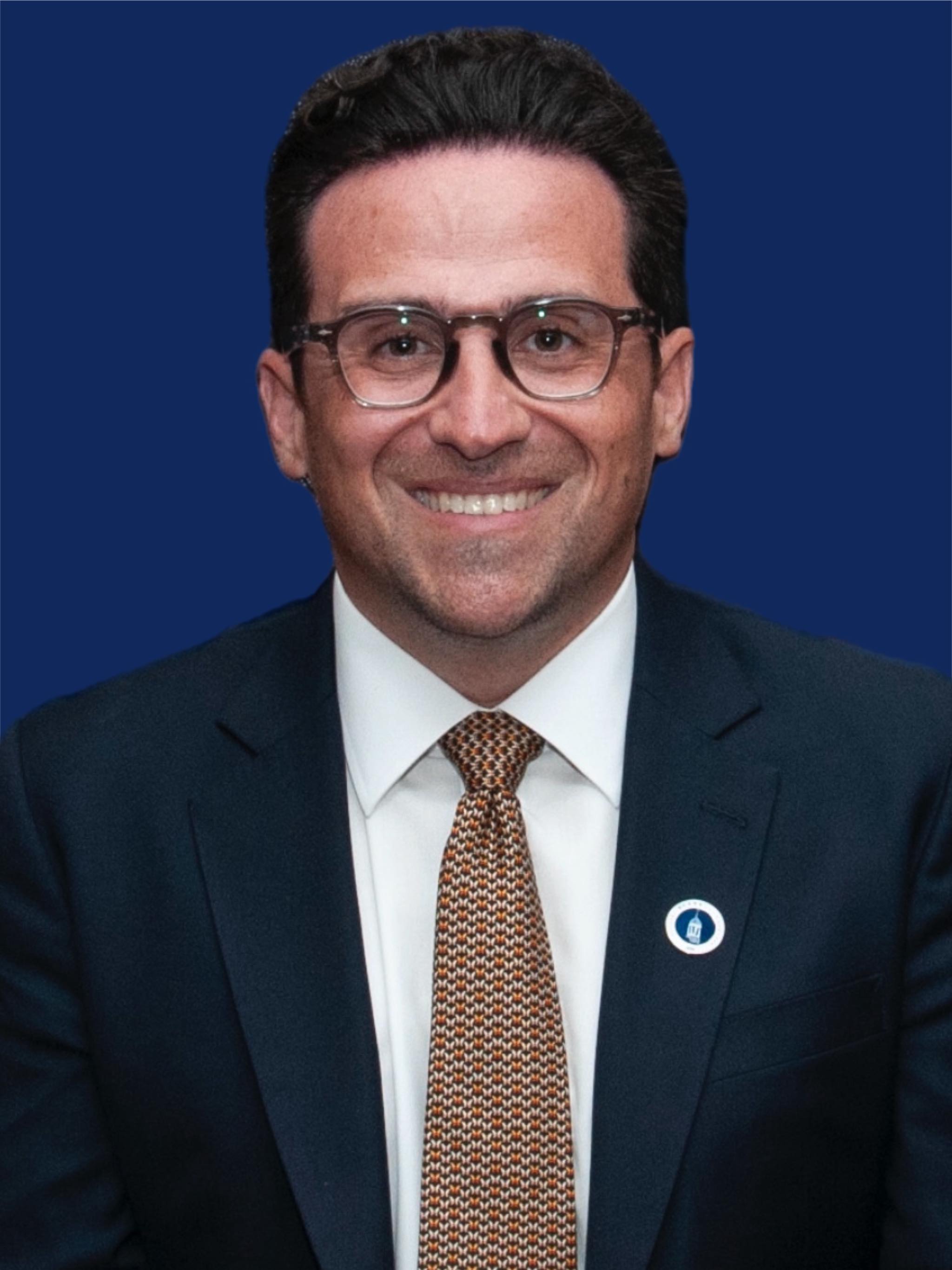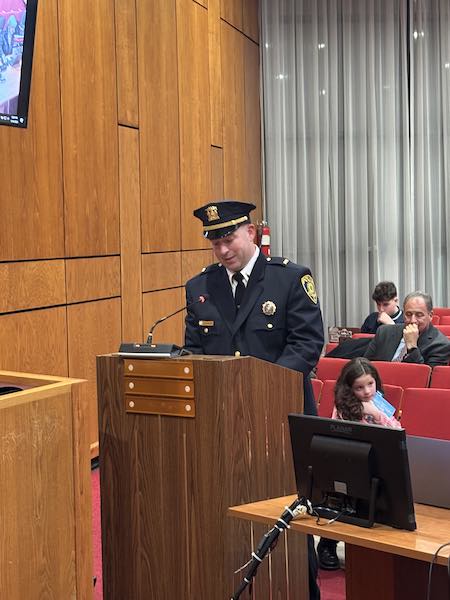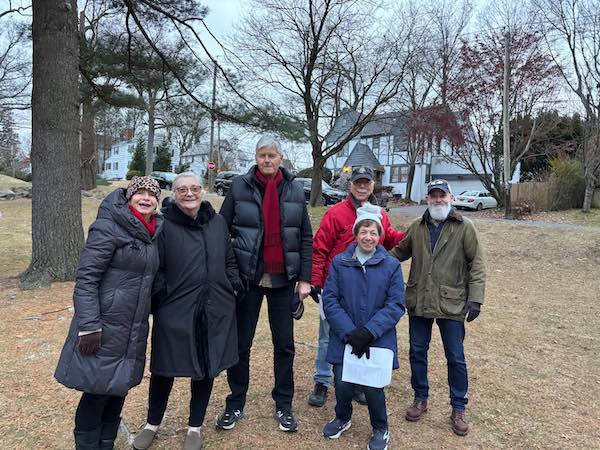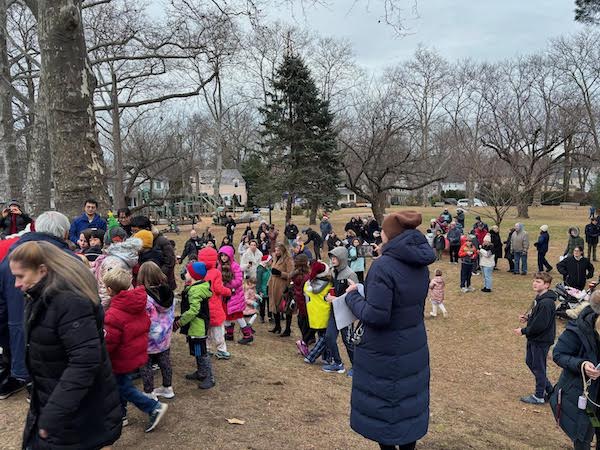Enterprising SHS Juniors Launch Hoops for Change
- Details
- Written by: Joanne Wallenstein
- Hits: 1392
 Zachary Kirschner and Jacob Friedland
Zachary Kirschner and Jacob Friedland
Two SHS juniors, Zachary Kirschner and Jacob Friedland, have found a way to make a meaningful impact on their community and the causes that are important to them while doing something they enjoy. "Basketball has always been something we both love," says Jacob, "so we thought, why not combine that with our passion for giving back?" Through their nonprofit organization, Hoops for Change, Zachary and Jacob have been able to do just that—organizing local tournaments that have raised over $4,000 for various charities, including Backyard Sports Cares, IDF Brothers for Life, Soles 4 Souls, and most recently, Altadena Boys, which supports the relief efforts of the recent California fires.
By securing the courts, promoting the tournaments, managing sign-ups, collecting donations, creating the teams and tournament structure, and even refereeing the games, Zachary and Jacob are not just raising money, but also educating their peers about these important charities.
"We want people to understand that it's not just about playing a game—it's about making a difference” says Zachary. "It’s been awesome to see our friends get involved and support and learn about the causes we care about." Through their efforts, they’re fostering a spirit of generosity and unity within their community. 36 people played in a tournament on the Lunar New Year organized by Hoops for Change.
36 people played in a tournament on the Lunar New Year organized by Hoops for Change.
For these two students, this is only the beginning. “We’ve got a lot of exciting plans ahead,” Zachary shares. “We’re already working on more tournaments this spring, and we hope to keep growing and helping as many people as possible.” With big ambitions for the future, Zachary and Jacob are determined to continue using basketball as a force for good.
Want to get involved? Follow @_hoopsforchange on Instagram to stay updated on their upcoming events and see firsthand how two high school students are changing the game—on and off the court.
CNC Nominates Arest for Mayor and Goldschmidt, Gruenberg and Kofman for Village Trustee
- Details
- Written by: Joanne Wallenstein
- Hits: 3847
 Justin Arest
Justin Arest
Mayor Justin Arest has been nominated by the Citizen's Nominating Committee to run for a second two-year term as the Mayor of Scarsdale. This may be the first time in Scarsdale's history when a Mayor was nominated to serve a second term. In addition, Deputy Mayor Dara Gruenberg received the nomination for a second term as Village Trustee and David Goldschmidt and Jason Kofman were selected to run for their first terms on the Scarsdale Village Board of Trustees.
Current Village Trustees Karen Brew and Sameer Ahuja will complete their service in March, 2025.
Commenting in his nomination, Mayor Arest said, "I am profoundly grateful to the members of the Citizens Nominating Committee for their service to our community and their commitment to Scarsdale’s longstanding nonpartisan system of government. While I did not anticipate seeking another term, I am deeply honored to have been renominated to run for a second term as the Mayor of Scarsdale.
The past two years have been incredibly productive for our village—adding services like weekly recycling, addressing critical flooding infrastructure, hiring a new village manager, and advancing major capital projects that improve our quality of life. These accomplishments are the result of collaborative efforts among our talented and dedicated village staff, my fellow board members, and countless volunteers whose commitment to Scarsdale is what makes this such a special place to live.
I look forward to welcoming the new trustees and continuing to work with the Village Board to serve our community."
See the announcement from the CNC below:
(The following was submitted by the Scarsdale Citizens Nominnating Commiittee on January 23, 2025)
The Citizens Nominating Committee (CNC) is pleased to announce its selected slate of candidates for the upcoming Scarsdale Citizens Non-Partisan Party election, scheduled for March 18, 2025.
The nominated candidates are:
Village Mayor:
Justin Arest, a Scarsdale resident for 12 years, currently serving as Village Mayor.
Village Trustee:
David J. Goldschmidt, a Scarsdale resident for 22 years
Dara Gruenberg, a Scarsdale resident for 13 years, currently serving as Village Trustee and seeking a second term.
Jason Kofman, a Scarsdale resident for 12 years Dara Gruenberg
Dara Gruenberg
The general election will take place on Tuesday, March 18, 2025, at the Scarsdale Public Library, 54 Olmsted Road, in the Scott Room. Voting hours are from 6:00 am to 9:00 pm.
Raju Sitaula, Chair of the CNC, and Vice Chair Scott Harris led the committee in selecting this slate. Additionally, the CNC has elected Amy Frank as Chair and Liang Leon Xi as Vice Chair for the upcoming year, with Dan Besikof serving as Vice Chair of the Procedure Committee.
Beginning in early December 2024, the CNC conducted a thorough search for potential candidates, engaging in extensive due diligence. While deliberations and reference conversations remain confidential, the CNC meticulously evaluated each candidate's background, experience, and qualifications.
"We extend our gratitude to all candidates who submitted application and to the CNC members for their dedication and diligence in selecting this exemplary slate of candidates,” said Raju Sitaula. David Goldschmidt
David Goldschmidt
The Citizens Nominating Committee (CNC) is a non-partisan committee composed of 30 elected Scarsdale residents dedicated to identifying and nominating highly qualified individuals for village offices to ensure effective and representative local governance. The CNC process is conducted with strict confidentiality to maintain fairness and integrity and is guided by the rules set by the Procedure Committee and the Non-Partisan Resolution.
This year, the CNC has made the decision to nominate Justin Arest for a second two-year term as Village Mayor. This decision marks a departure from the CNC’s tradition of nominating Mayors to one two-year term. During the CNC’s rigorous review process, which included an examination of Village statutes and historical documents, it was confirmed that this tradition is a customary practice  Jason Kofmanand is not a requirement. After extensive deliberation, the CNC members voted to nominate the candidate they felt is best positioned to lead our village for the next two years.
Jason Kofmanand is not a requirement. After extensive deliberation, the CNC members voted to nominate the candidate they felt is best positioned to lead our village for the next two years.
Additionally, the Chair and Vice Chair of the CNC have recommended to the Procedure Committee a review of term limits for Village elected officials to ensure that CNC policies align with the evolving needs of the community.
Village Board Appoints New Police Chief and Recognizes Holocaust Remembrance Day
- Details
- Written by: Joanne Wallenstein
- Hits: 2757
 Newly appointed Chief Steven DelBene poses for a photo with the Village Board, Mayor and Village ManagerWith Scarsdale Police Chief Andrew Matturro’s retirement just a few weeks away, the Village Board appointed a new chief for the Village at their meeting on January 14, 2025. They also issued a resolution denouncing hate, discrimination and antisemitism. See below:
Newly appointed Chief Steven DelBene poses for a photo with the Village Board, Mayor and Village ManagerWith Scarsdale Police Chief Andrew Matturro’s retirement just a few weeks away, the Village Board appointed a new chief for the Village at their meeting on January 14, 2025. They also issued a resolution denouncing hate, discrimination and antisemitism. See below:
Announcing the appointment of the new police chief, Mayor Justin Arest explained, “Tonight, we have the privilege of voting on a resolution to appoint Lieutenant Steven DelBene as the next Police Chief of the Scarsdale Police Department. This appointment reflects not only the strength of Lieutenant DelBene’s distinguished career, but also the values of professionalism, innovation, and community service that are central to our department.
Lieutenant DelBene began his career with the Scarsdale Police Department nearly two decades ago, in 2006. Over the years, he has risen through the ranks, earning the respect and trust of his peers and our community. His roles have spanned from patrol officer to sergeant, and most recently to lieutenant, where he has helped guide a team of 52 sworn and civilian personnel. At every stage of his career, he has demonstrated the ability to inspire confidence, foster collaboration, and ensure operational excellence.
In addition to his operational duties, Lieutenant DelBene has spearheaded several critical initiatives that have significantly strengthened the department’s readiness, transparency, and officer wellness. His notable contributions include the implementation of the department’s first-ever body-worn camera program, the modernization of our radio system, and the introduction of an innovative wellness program—including the department’s first wellness canine, a first for Scarsdale. These efforts highlight his ability to drive positive change by blending operational efficiency with forward-thinking strategies that directly benefit both our officers and the broader community.
Lieutenant DelBene’s professional development further underscores his qualifications. He is a proud graduate of the FBI National Academy, one of the nation’s premier law enforcement leadership programs, and holds a Master’s degree in Public Administration from Marist College. These academic achievements, combined with his extensive field experience, uniquely position him to guide the Scarsdale Police Department into the future. Chief DelBene accepts his new job.
Chief DelBene accepts his new job.
Lieutenant DelBene’s dedication, integrity, and progressive approach to modern policing have prepared him well for this new role. I am confident that, under his leadership, the department will continue to uphold the highest standards of public safety while strengthening its partnership with the community.”
Accepting his new role DelBene said, “I am honored and humbled to stand before you as your next Chief of Police for the Scarsdale Police Department. I want to begin by sincerely thanking the board for placing your trust and confidence in me to lead this exceptional department. Over the past 19 years, I've had the privilege of serving this community in various capacities, and in that time, I've come to truly understand and appreciate what makes Scarsdale so special. Our community is not only rich in tradition and pride, but it is also home to an engaged and supportive citizenry that partners with its police department to create an unparalleled standard of public safety. This promotion is not just a professional milestone for me, it's a responsibility I take to heart. I am deeply committed to ensuring that the scars go to department continues to reflect the high standards our residents expect and deserve.
We face exciting opportunities and challenges ahead, from enhancing public safety, to technology and Innovation and continuing to foster a culture of excellence and professionalism within the department.
…..I promise to serve with transparency, accountability and an unwavering dedication to protecting and enriching this wonderful community. I look forward to working together to ensure that Scarsdale remains a safe, vibrant and thriving place for all. Lastly, I would be remiss if I didn't thank my family. They have made sacrifices along with me in order to for me to get where I am today, here with me today. You all met my daughter, Ava. Unfortunately, my wife, Julia, is at home taking care of our son, Ryan, who's sick. Otherwise they would have joined me tonight, Julia, I know she's watching. I am so lucky to have had you stand by my side throughout my entire career. I could not have done this without you again for this incredible opportunity.”
License Agreement with the Scarsdale Schools
Recognizing an arrangement for the Village to use school-owned property for the placement of playground equipment at Greenacres field, the Board passed a license agreement for the use of the property.
The rationale is as follows:
“The Scarsdale Union School District owns a parcel of land on Huntington Avenue, adjacent to Greenacres Elementary School and is used by the School District during the academic year as a school playground. Historically, the Village of Scarsdale has maintained playground apparatus in the southeast corner of this property, referred to as the Village Playground. However, there has not been an agreement formalizing the Village s use of this portion of the School District property.
The Village recently purchased and installed new playground apparatus at the aforementioned property in September of 2024, and both the School District and the Village agreed that this was an ideal time to formalize the relationship regarding use of the playground. Attached is a draft license agreement, prepared and reviewed by both School District and Village staff. The agreement is for a term of five (5) years, with an option to extend for additional five-year terms upon mutual agreement of both parties.”
Appointment to the Board of Architectural Review
Lori Falow was appointed as an alternate to the Scarsdale Board of Architectural Review
Assistant Village Manager
The Board approved a resolution to modify Village code to permit the appointment of three rather than two assistant Village Managers.
Donations
The Village Board accepted two donations from the Fenway Golf Club Charitable Fund. One for $5,000 for the Scarsdale Police to purchase equipment and another for $5,000 for the Scarsdale Fire Department to support the firefighters in their duties.
Taxi Service
In response to a request for financial relief from Scarsdale Taxi, the Village Board passed a resolution to pro-rate fees for taxicab licenses on a monthly basis to $10 per taxicab for the 2025 calendar year. This replaces semi-annual payments and will help to ensure that taxicab service remains available in the Village.
Explaining the change, Mayor Arest said, “As you may know, the village government does not operate the taxi service in Scarsdale, nor do we hold, nor do we hold control of the station spots utilized by the taxi company. Additionally, we do not have the authority to license or regulate certain for higher transportation services that operate within our borders. However, when it comes to taxis, specifically, we do have the ability to require driver and vehicle licenses. With that in mind, we have been in communication with Scarsdale taxi operator and have worked collaboratively to support their efforts to maintain essential taxi service for our residents who depend on it. To that end, we are proposing an amendment to our code that will allow the vehicle license fee to be paid on a monthly basis, rather than yearly or semi-annually, for 2025.”
Holocaust Remembrance Day
The Scarsdale Board of Trustees passed a resolution recognizing the 80th anniversary of the liberation of Auschwitz-Birkenau and denouncing hate. During a moving moment of the proceedings, the entire board signalled their support for the resolution by each reading a section of the following resolution aloud:
WHEREAS, January 27 is recognized as International Holocaust Remembrance Day, commemorating the anniversary of the liberation of Auschwitz-Birkenau and honoring the memory of the six million Jews and millions of others who perished during the Holocaust; and
WHEREAS, this International Holocaust Remembrance Day will mark the 80th anniversary of the liberation of Auschwitz-Birkenau, serving as a powerful reminder of the responsibility to preserve historical truth, learn from the past, and take a resolute stand against all forms of antisemitism, intolerance, and hate; and
WHEREAS, antisemitism, defined as hostility, prejudice, or discrimination against Jewish individuals, is a persistent and pernicious threat with a long history of inciting division, violence, and societal instability, and continues to pose grave risks in the United States and globally; and
WHEREAS, history demonstrates that antisemitism has repeatedly served as a precursor to broader societal intolerance, igniting cycles of hatred that spread beyond Jewish communities and weaken the bonds of our shared humanity; and
WHEREAS, the Village of Scarsdale is unwavering in its commitment to fostering a safe, inclusive, and respectful environment for all residents, grounded in the principles of dignity, equality, and mutual respect; and
WHEREAS, the rise of hate crimes and bigotry, including acts of antisemitism, serves as a stark reminder of the deeply interconnected and escalating nature of prejudice, demanding immediate and resolute action to confront and eradicate hatred in all its forms; and
WHEREAS, in June 2022, Governor Kathy Hochul issued a proclamation embracing the International Holocaust Remembrance Alliance (IHRA) working definition of antisemitism, recognizing its importance as a tool to help identify and combat antisemitic acts, thereby providing guidance to ensure that all New Yorkers are protected from such hatred; and
WHEREAS, in December 2022, former Westchester County Executive George Latimer issued an Executive Order adopting the IHRA working definition of antisemitism for Westchester County, an action publicly praised for demonstrating leadership and providing a clear standard to identify and address antisemitic incidents at the county level; and
WHEREAS, the IHRA working definition of antisemitism, endorsed at both the state and county levels, provides a globally recognized standard that enhances the ability to identify, understand, and combat antisemitic speech and actions; and
WHEREAS, the Village of Scarsdale unequivocally condemns hatred, bias, racism, and discrimination in all forms, recognizing that such ideologies undermine the fundamental values of inclusivity, solidarity, and respect that are essential to a thriving and united community.
NOW, THEREFORE, BE IT RESOLVED, that the Village of Scarsdale, through its Mayor and Board of Trustees:
1. Unequivocally condemns antisemitism in all its forms and recognizes its profound impact on Jewish communities and society at large as a dangerous manifestation of hate that cannot be tolerated.
2. Endorses and adopts the IHRA working definition of antisemitism, in alignment with Governor Hochul’s 2022 Proclamation and former County Executive Latimer’s 2022 Executive Order, as a guiding tool to identify, prevent, and respond to antisemitic acts and rhetoric.
3. Reaffirms its commitment to combating all forms of hate and discrimination, acknowledging their interconnected nature and the shared responsibility to build a community where all individuals feel safe, respected, and valued.
4. Encourages residents to report incidents of hate and discrimination, ensuring that such reports are addressed with urgency, transparency, and accountability while providing comprehensive support to affected individuals and communities.
5. Pledges to collaborate with law enforcement, educational institutions, and community organizations to strengthen strategies for preventing and responding to hate incidents, promoting a proactive and inclusive approach to community safety; and,
BE IT FURTHER RESOLVED, that the Village of Scarsdale stands in unwavering solidarity with all communities impacted by hate, recognizing that an attack on one is an attack on all, and commits to leading by example in upholding and advancing the values of respect, inclusivity, and unity. Let this resolution serve as a reaffirmation of the Village of Scarsdale’s resolve to confront and eradicate hate in all its forms, ensuring that the village remains a beacon of hope, acceptance, and justice for all; and,
BE IT FURTHER RESOLVED, that the Village Clerk is hereby directed to transmit a copy of this resolution to all Department Heads, the Superintendent of the Scarsdale Union Free School District as well as said District’s Board of Education President; and,
BE IT FURTHER RESOLVED, that it is recognized that Mayor Arest has proclaimed that January 27, 2025 is to be officially recognized as International Holocaust Remembrance Day in Scarsdale.
Tax Collections and Payments Due
Village Treasurer Ann Scaglione reported the following:
The tax collection percentages are:
-99.67% of the 2024 county tax levy has been collected.
-63.02% of the 2024 school tax levy has been collected
-97% of the 2024 village tax levy has been collected.
She reminded the public that the second installment of the 2024 school tax is due on or before January 31, 2025.
Paulin Sponsors Bills to Improve the Healthcare and Well Being of New Yorkers
- Details
- Written by: Joanne Wallenstein
- Hits: 1577
 As one of the most productive representatives in the NYS Legislature, over 400 of Amy Paulin’s bills have been signed into law to date. First elected in 2001, she now chairs the Assembly Committee on Health and serves on the Committees on Rules and Education. This session she continued to sponsor legislation to improve the health and well-being of New Yorkers.
As one of the most productive representatives in the NYS Legislature, over 400 of Amy Paulin’s bills have been signed into law to date. First elected in 2001, she now chairs the Assembly Committee on Health and serves on the Committees on Rules and Education. This session she continued to sponsor legislation to improve the health and well-being of New Yorkers.
Here are just a few of the bills that were signed in to law – and others that were vetoed by the Governor.
Governor Hochul signed into law three key pieces of legislation that she authored (Chs. 520, 476, 474 of 2024) which will help address healthcare workforce shortages and expand healthcare access for New Yorkers.
A.8378/S.9038 increases the number of physician assistants (PAs) that can be supervised by a physician. It further provides that PAs may prescribe and order non-patient specific orders for certain immunizations and treatments and write medical orders for durable medical equipment.
“During the pandemic, under the Governor’s executive orders, PAs were given greater latitude to treat patients, taking full advantage of their extensive training and experience,” said Assemblywoman Amy Paulin. “Patients, hospitals and clinics throughout New York benefitted from the increased access to care during that time. Many New Yorkers still face barriers to health care which stem from a shortage of health care professionals. By modernizing practice guidelines for PAs, this law will increase the number of providers available to treat patients, expanding access to quality care across the State.”
A.8247C/S.8470 expands access to radiology services by authorizing the intravenous administration of contrast media by a radiographer when done under the direct supervision of a licensed physician, certified nurse practitioner, or licensed physician assistant.
“By allowing physician assistants and nurse practitioners to supervise the administration of IV contrast media, we’re cutting down unnecessary delays in care for procedures like MRIs and CT scans,” said Assemblywoman Amy Paulin. “This will allow radiologic technologists to work more efficiently, give New Yorkers high quality and timely care, and allow physicians to focus on critical patient care. This is a commonsense way to address the healthcare workforce shortage and increase healthcare access by increasing efficiency.”
A.8168/S.7690 provides Medicaid coverage for remote ultrasound scans and remote fetal non-stress tests. While NYS Medicaid provides coverage for telemedicine services, coverage of remote ultrasound scans and remote fetal non-stress tests has been ambiguous. This new law clarifies and codifies that remote ultrasound scans and remote fetal non-stress tests are fully covered by Medicaid.
By increasing access to remote interventions, this new law will prevent gaps in care for rural New Yorkers, enhance access to care for all expecting mothers, and improve health outcomes for New York’s moms and babies.
Paulin’s Parkinson’s Disease Registry Bill was signed into law. The legislation will establish a state Parkinson's Disease Registry (A.5803/S.4674) which would provide for the collection of data on the incidence and prevalence of Parkinson’s disease (PD). The registry will help expand understanding of PD and advance research towards prevention, treatment and an eventual cure.
A registry of people with Parkinson’s will help researchers identify high-risk groups, detect prevalence patterns among the New York population, and uncover disparities in treatment in marginalized communities. Currently, ten other states, including California, already have such a registry.
“There are many researchers, doctors and advocates who are working to win the battle against Parkinson’s Disease,” said Paulin. “I’m proud to have authored the Parkinson’s Disease Registry bill to help in their fight against this disease, and am thrilled that it has now been signed into law. The more data we can give to researchers, the better they can direct their efforts to find a cure and more advanced therapies.
(A.9632/S.9144) which eliminates the funding cap for New York’s Spinal Cord Injury Research Program was signed by the Governor.
In 1998, through the advocacy of Christopher Reeve and State Police Sergeant Paul Richter, the Spinal Cord Injury Research Program (SCIRP) was established in New York State. Both men had serious spinal cord injuries that resulted in paralysis. Given that most spinal cord injuries result from vehicle accidents, the State Legislature chose to fund the research program through a surcharge on moving traffic violations. The original legislation placed an arbitrary statutory cap of $8.5 million on the amount that could be dedicated to SCIRP funding, which has never been increased. The surcharge being generated is now higher than that amount and could increase the SCIRP’s funding.
“Research funded by SCIRP has led to breakthroughs that allow individuals with spinal cord injuries to regain the use of their arms and hands and enhance the quality of life for those with spinal cord injuries,” said Assemblywoman Amy Paulin. “New York is one of only a few states funding this important research. By uncapping SCIRP’s funding we’ll have an opportunity to continue leading the nation in groundbreaking progress for spinal cord injury research. Plus every dollar in SCIRP funds leverages seven dollars in funding from the federal government.”
Governor Kathy Hochul signed (Ch. 543 of 2024) into law. The legislation mandates cell phone carriers limit or disable service to stolen cell phones.
This law requires that cell phone carriers maintain a program to prevent the activation of a cell phone which appears on the GSMA Block List, a global registry of lost, stolen, fraudulent or broken devices. When a carrier is notified by a retail store selling new phones or by a verified customer that a phone has been stolen, the carrier is required to suspend or prevent the activation of the device.
“Any robbery has the potential to turn into something violent, which we saw in New York City, where Detective Brian Simonsen was tragically killed during a cell phone store robbery,” said Assemblywoman Amy Paulin. “We need to keep our officers and residents safe, and this is a commonsense step in that direction. If robbers know they won’t be able to use the phones they steal, there’s no reason to steal them.”
Bills Vetoed
However the Governor also vetoed several laws championed by Paulin. Among them was a bill sponsored by Paulin which would permanently carve out school-based health centers (SBHCs) from Medicaid Managed Care, which has the potential to cause fiscal stress to SBHCs, affecting the healthcare for the many New York children who rely on SBHC’s for primary care.
SBHCs provide comprehensive physical, chronic, mental, and dental health services to over 350,000 New York youth, regardless of insurance status or ability to pay. They play a crucial role in ensuring that all children receive the care they need.
“SBHCs increase access to health services for children, reduce ethnic and racial disparities in healthcare, and improve school attendance and performance,” said Assemblywoman Amy Paulin. “They provide care to every child who enters their door, regardless of insurance status or ability to pay and serve as a critical point of care for the state’s most vulnerable children who may otherwise fall through the cracks.”
Since 1985, SBHCs have operated under a "carve out" from Medicaid Managed Care (MMC), receiving direct fee-for-service reimbursements from New York State. However, recent proposals have threatened to end this arrangement, potentially forcing SBHCs to negotiate with managed care plans.
Another vetoed bill was Paulin’s Bedsore Prevention Program, a bill which would require hospitals and residential healthcare facilities to implement a pressure ulcer (bedsore) prevention program has been vetoed by Governor Hochul. The program makes bedsore prevention in healthcare facilities a priority and ultimately mitigates the prevalence of patients getting bedsores. Paulin’s legislation also mandates that the NYS Health Commissioner evaluates the current reimbursement policy for pressure ulcer prevention programs and reports on the current reimbursement options.
“With the right resources, healthcare facilities have the ability to prevent pressure ulcers and the added pain for patients,” said Assemblywoman Amy Paulin. “Pressure ulcers are not an inevitable consequence of limited mobility, they are a failure of care. The program proposed by my bill would have created a systematic approach to prevention, training healthcare providers to be proactive against pressure ulcers.”
Pressure ulcers, also known as bed sores, occur when there is prolonged pressure on one spot on the skin which harms the tissue underneath. Individuals with limited mobility or those who are completely immobile may develop pressure ulcers due to not being able to change positions when lying down. Pressure ulcers can lead to more serious conditions like sepsis and bone infections if left untreated. In the United States, there are more than 2.5 million cases of pressure ulcers each year.
Also vetoed was a bill to address the unacceptably slow contract and procurement process faced by non-profit organizations that contract with New York State. S.4877A.2740B. The bill would have required agencies that fail to submit renewal contracts to the Attorney General or execute them in a timely fashion to report to the State Comptroller on the status of those late contracts. The bill also would have required agencies with delayed contracts to report to the Comptroller on barriers to submitting and executing contracts in a timely manner, and their plans to address those issues.
New York State relies on not-for-profits for everything from early education childhood programs to safety net services including mental health assistance, homeless shelters and legal counseling. The state outsources to and relies on not-for-profits to provide these services, and without them many programs would not even exist. These agencies are performing work that the state is obligated to do by law. It would be more expensive if the state did the work. Unfortunately, the timeliness of the state’s contracting process and procurement is consistently slow, delaying payments and often undermining the financial stability of these organizations.
Another veto was a bill that would allow everyone to have access to medical equipment and technology, especially the elderly and most vulnerable. “I am deeply disappointed with Governor Hochul’s veto of A.6022a/S.4787a,” said Assemblywoman Amy Paulin. “This legislation would provide a more streamlined and transparent process for providers, and the public, to have new and advanced medical technology and services covered by Medicaid.”
Currently the Evidence Based Benefits Review Advisory Committee (EBBRAC) determines what services and technologies Medicaid should cover. Under EBRAC’s current setup, they must contract with an outside vendor who reviews new potential contracts. However EBBRAC has been without a vendor since 2017. This legislation would change the EBBRAC process to ensure that the Health Department maintains the ability to approve or disapprove new technologies or services without a vendor. The bill also requires EBBRAC to maintain periodic reviews of pending applications.
Arthur Manor’s 95th Annual Holiday Celebration in Davis Park
- Details
- Written by: Matthew Martin
- Hits: 1115
 Arthur Manor is making history. On a chilly and overcast Sunday afternoon, December 15th, 2024, the Arthur Manor Neighborhood Association celebrated its 95th annual holiday sing and tree lighting ceremony in Davis Park. This annual event in Davis Park began in 1918, the founding year of the Arthur Manor Neighborhood Association.
Arthur Manor is making history. On a chilly and overcast Sunday afternoon, December 15th, 2024, the Arthur Manor Neighborhood Association celebrated its 95th annual holiday sing and tree lighting ceremony in Davis Park. This annual event in Davis Park began in 1918, the founding year of the Arthur Manor Neighborhood Association.
The day’s festivities began with the crowd singing their favorite Christmas and Hanukkah songs which were all expertly directed by the voice of Arthur Manor’s own Jeanie Bongiorno. Hot chocolate, brownies, holiday cupcakes and cookies were provided by all of the volunteer residents who helped make the day a special one in Arthur Manor.

After the holiday caroling finished, the annual holiday event then included the lighting of the large pine tree in Davis Park by Arthur Manor resident Maura Danahy. The tree lights were strung earlier in the week in Davis Park under the direction of Scarsdale’s Public Works and the dedicated Pubic Works’ crew.

The crowd on Sunday also included Lou Mancini and many other active members of Scarsdale Volunteer Fire Company Number 1, founded on Sprague Road in Arthur Manor in 1893. Scarsdale’s Volunteer Fire Company Number 1 is an integral part of the Arthur Manor association.

Following the group sing, everyone’s all-time favorite, Santa Claus (played by long time Arthur Manor resident Rick Wingate), arrived at Davis Park in true style in an antique 1946 Scarsdale Fire Department truck driven by another long time Arthur Manor resident Michael Keating.

After Santa completed his rounds in Davis Park with many photographs taken and all of the candy canes handed out to the children, Santa Claus left the group at Davis Park to visit other holiday celebrations in Scarsdale and beyond.

This annual festivity in Arthur Manor’s Davis Park is made possible by the collective efforts of the many Arthur Manor volunteers including especially the Marcus, Roche, Porco, Salazar, Stuart and Bongiorno families, and all of the other Arthur Manor volunteers too numerous to list here. Many good memories were made on Sunday and the Arthur Manor Board of Directors wishes to thank everyone who helped to make this year’s 95th celebration so special.


- News from Village Hall: DeCicco and Sons to Open in Scarsdale Village, Weekly Recycling Pickup to Begin in January
- Affordable Housing in Westchester: LWVS Invites Experts to Explain
- Trustees Unveil Schematic of Reimagined Pool Complex
- Consultants Present Recommendations for Scarsdale's Fields and Courts










